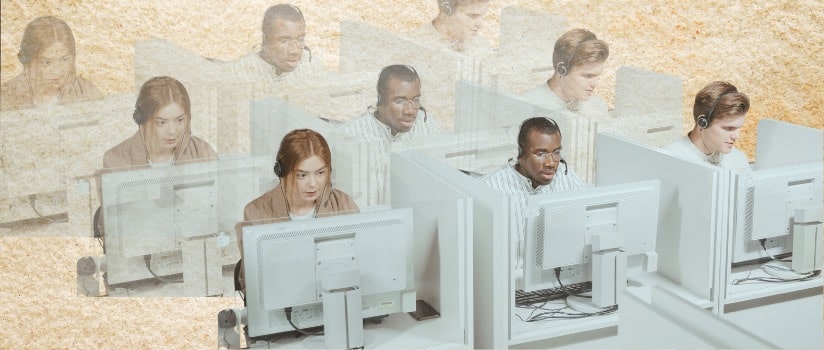The Organization is Here to Support You
(An excerpt from the novel The Organization is Here to Support You, forthcoming from Weirdpunk)
We live and work in the units, and the office people live and work in the office. It used to be that when it was time for the members to come evaluate applications, we would all go to the office and pretend like we worked there all the time. But otherwise, the software sufficed to allow us to communicate and to meet productivity standards.
We might never have figured that out, if the new office hadn’t failed so catastrophically.
Oh god, that new office.
The new office was a terrible idea.
It always had been.
The executives wouldn’t listen to anyone.
The idea of the new office seemed so novel, so futuristic. They were going to revolutionize the workspace. No one would have desks. There would be zones for independent work and other zones for collaborative work, zones for internal meetings, and zones for meeting with external stakeholders. We asked if the executives would have to work in the zones as well, but no one answered.
You get to know the meaning of silence. Silence is always the answer everyone assumes but doesn’t want to be true.
In a building attached to the new office, accessible through the main floor hallway, we’d have our units. In the underground corridor between the units and the office, there would be retail and other commercial space—an optometrist, a dentist, a courier and restaurants. Our internal surveys had shown that a significant factor negatively impacting workplace satisfaction was the commute. The old building was downtown; there was no parking, and the number of people coming in on public transit meant that not everyone could possibly arrive at once. That was how the notion of flexible hours actually started. We had to stagger arrival times so as not to overwhelm the light rail transit system.
The organization eliminated the commute by providing us with units furnished with beds and a small kitchen area. In the interest of equity over equality, the units were customizable to an individual’s requested reasonable accommodations. Some of my colleagues resisted the units—for a while—because they thought that if they both lived and worked at the organization, they would become mere drones, never out of the organization’s sight, always acting for its purposes and in its interest, nowhere to think for themselves.
They thought a unit would make them a less than one.
As we moved into our units and started working in the new office, issues quickly became apparent. Without assigned desks, we had to bring our equipment home at night. Some of my colleagues became attached to certain workspaces and started coming in earlier and earlier to make sure they could claim them. Tensions rose, and some individuals began sleeping in the office, like nerds in the overnight line at an electronics shop whenever a new video game system was released, except the only reward here was “the good corner.”
The real problem, as we told the executives, was that the new office only had fifty percent of the space of the old office. But the executives assured us that the space was designed to encourage movement, and that movement would ensure that no one was ever in the space that anyone else would need—not at the same time.
They were wrong. Having no assigned space meant that no one moved; everyone became static, afraid to leave their preferred area for fear that the area might be conquered by another, who had as much claim to it as they did. The fifty percent of people who were always supposed to be in transit from one area to another didn’t exist. The zones became crowded, everyone politely agreeing to share the space while staunchly maintaining a territorial boundary.
The first person I remember retreating to the units entirely was Amira. We walked into the new office together on the first day it opened, with our laptops in our matching carrying cases, the organization’s logo emblazoned across our backs. The union had demanded the technology packs, once it figured out that we’d have to transport the 8-pound computers morning and night, to the office from home or the units in the morning, and back again. The technology packs were ergonomic.
On that first day, Amira and I walked through the automatic safety glass doors and looked around for a place to set up. The straps on my technology pack were digging into my shoulders, but I figured my body would become accustomed to it over time. Amira’s expression turned quickly to despair when she realized there was no space set aside for employee belongings, including the meals we had packed for the afternoon, to avoid the extra cost of the restaurants. “Where am I supposed to put my lunch?” she asked. I didn’t know. I didn’t bring one. “I guess I’ll go put it back in the fridge in my unit,” she said, and that was the last I saw of her in the flesh. On the screen, from then on, she was always in a unit.
I kept going into the office, finding space where I could, going down to the first floor for food, trying to make myself into a unit as much as I could, transportable from place to place, like the organization wanted. Self-sufficient, self-encapsulated, self-enclosed. I moved around and whenever I did, packed my things. I brought my workstation to lunch, to the bathrooms, to the basement retail outlets.
After about a hundred days, those of us who had moved into the units discovered that our out-of-office colleagues had been wrong about something. The danger of putting our units so close to the office wasn’t that we would become drones for the organization. It was that the organization would become our home.
We infested it, like cockroaches with no concept of property law.
That is to say, we formed a well-ordered society, using the resources available to suit our purposes in order to optimize our living and working situations. With the executives a safe distance away, leaders emerged from among our set, whom we designated our “social coordinators”—an unpaid volunteer position with a time release from our normal functions. Nobody asked for the executives’ approval. As they had told us, this space was ours, and we made it so. The first thing that had to be done was to provide reasonable accommodation to our anxious colleagues, who were already showing symptoms of a failure to thrive in the forced socialization environment imposed upon us. We sectioned off portions of the independent work zone and built barriers to enhance the illusion of distance. There were so many anxious people working for the organization, though, that the collaborative zones also had to be sectioned off.
As the space became reorganized in the manner to which we had become accustomed in the old office, less of it was available. At our morning meetings, the social coordinators would ask for volunteers to go work in their units that day. Then, to avoid having to ask every day, the social coordinators started asking for volunteers to go work in their units for the week. Every week, the same people volunteered and more, myself included, until finally, there was established a fixed subset of the workforce that remained in the office.
And they changed.
For a while, we could see from their backgrounds at the virtual meetings how the office was changing behind them. From the way they interacted, it was clear that there were new alliances, newly established social conventions. Jokes we didn’t get. As long as the work continued, upper management did not concern themselves. But our colleagues were undergoing a transformation unprecedented within the organization. McKenzie, concerned for the organization’s liability, once mentioned aloud the change to the proportions of their musculature. But rather than respond to the comment or request accommodation, the office people started taking our calls off camera. Their profile pictures replaced their online presence, the same ones we all had, with our shoulders angled forty-five degrees away from the camera, smiling straight on, the office hallway in the background. Within three months, they stopped meeting us, even audio only, their voices having noticeably risen and sharpened in the interim. Now evidence of their existence could only be gleaned by document version controls and the productivity software that continued to log their movements. The Committee for Health, Safety, and Accommodations speculated that the change was due to radon in the office building’s air supply, which wasn’t subject to the same building standards as the living quarters and therefore wasn’t built to the same standard.
We have learned not to ask about them. We have retained our territory in the units and abandoned the office entirely. Although we might have expected to meet them in the tunnels, it seems they have elected to conduct their business there after hours—if they have any lingering business at all. It is no longer clear how the office folk live, nourish themselves, or what hierarchical system has arisen amongst them to ensure the continued functioning of the organization.
The office had always been a bad idea.
- The Organization is Here to Support You - February 13, 2025
* This is a work of fiction. Names, characters, places, and incidents are producs of the author's imagination. Any resemblance to real events or persons, living or dead, is entirely coincidental.




